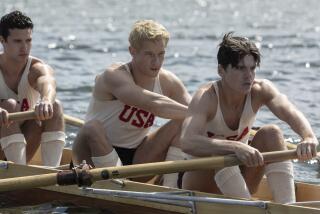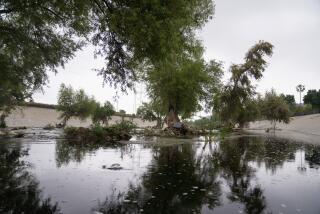The Boat People Had Nothing on This Man’s Escape
- Share via
When you and I think of canoeing, we probably think of something slithering down the waters of Moonlight Bay on a warm summer’s eve. You need a paddle and a ukulele and a straw hat and a girl with a parasol and an organdy bonnet.
Or maybe you like to think of Hiawatha or of the great French priest-explorers navigating down the mighty father of waters, the Mississippi, from the forests of the Great Lakes to the bayous of Louisiana.
The canoe is as uniquely an American vehicle as the hot rod. The covered wagon opened the West but it was the canoe that brought the coonskin caps and frontiersmen into the wilderness of Colonial America.
It was a most versatile vehicle. It sailed gracefully along still ponds or safely skimmed over the most treacherous rapids. It brought the furs that made the Astors rich, it let Lewis and Clark find an inland route to the Pacific Ocean.
It is also the New World’s oldest vehicle. Long before the white man came, it was the Indians’ only way to navigate the great streams. The birchbark canoe predated even the horse in this country. It was here when the Spaniards brought them. It was such a durable and reliable craft that the white man adopted it as his own. You would think these river craft would have long since been relegated to hanging on wires in the Smithsonian as a quaint artifact, but the facts are that America’s love affair with the canoe is far from over. The rivers may be polluted, the wildlife retreating, but wherever white water flashes over sullen rocks, there you’ll find the last of the Mohicans, so to speak, still testing their mettle against old man river.
Canoes are made of aluminum or fiberglass today and the canoe of choice frequently is the Eskimo version, the kayak, which is such a popular recreational vehicle that it has gone into the Olympics along with the conventional canoeing (Canadian) sport.
You might think that the most skilled racing canoeist would be someone named Two Ducks Flying or Standing Bull and he would wear a feather and string of beads. But the most avid advocate of the sport is a guy whose childhood was spent far from the rushing waters of the box canyons of the American West. In fact, it was spent first under the occupation of Hitler’s army, then under the guns of Red Army tanks.
Josef Sedivec may be the only guy who ever broke through the Iron Curtain in a canoe. He didn’t exactly paddle his way out in a hail of machine gun bullets but it was the same thing.
Joe had lived through the “Prague Spring” of 1968, the period when true democracy was supposed to be returning to his benighted Czechoslovakia, but he awoke one morning to find the streets of his native Prague patrolled by Soviet armor and the sky overhead black with incoming Russian warplanes.
That fall, in Belgium for an international kayak race, he jumped the club.
“They kept telling us how bad life in the West was, but we didn’t see any tanks on the street corners,” is the only thing he will say.
He showed up at the American embassy in Brussels with his canoe under his arm. It was the only thing he had that didn’t belong to the state. He asked for, and got, asylum.
As a child in Czechoslovakia, Joe Sedivec had become addicted to Wild West novels, both those written by a German author who never got west of the Rhine and by Zane Grey, and he also grew up reading the Leatherstocking stories of James Fenimore Cooper. The canoe became an object of romance to him. It symbolized freedom.
His first canoeing was in the white waters of the Carpathian mountains and the graceful bends of the Moldau but he became good enough to win world championships in kayaking singles and pairs before he defected to the West.
Sedivec, who showcases his line of racing and recreational kayaks and canoes at the Fred Hall Sportfishing Tackle and Boat Show at Del Mar Fairgrounds March 18-22, believes that Americans are returning to the source in droves in this decade, that they find even the most dangerous of boulder-strewn rapids soothing after days spent fighting freeway traffic.
“There are no traffic jams on white-water rivers yet,” he explains.
It is estimated that some 2 million Americans own canoes. Kayaks, which were the canoes made by Eskimos out of sealskins and whale blubber, are the original wraparound canoes propelled by two-bladed paddles and are of such sturdy construction that a kayaker--Ed Gillet--not only paddled the 1,200 miles from Glacier Bay, Alaska, to Seattle in one but also went up the coast of South America from Cape Horn to Panama.
A kayak, Sedivec says, can go anywhere the Queen Mary could. Kayakers have even raced down the slopes of Mount Everest.
It is a sport that has the additional exhilaration of adding drowning or concussion against a rock to the contest’s suspense but Sedivec points out that it is affordable. All the Indians needed was a birch tree and a few saplings but today’s canoeists can get a kayak for $400 to $900, depending on whether they want to cruise down the Arkansas River or race an Olympic course.
The original freeways in this country were the rivers and streams traversed by the original commuters like the Mohawks and Mohicans. And negotiating the rushing white-water parts by canoe may be no worse than taking on an on-ramp at rush hour on the Ventura.
The canoe is as American as turkey with gravy. The Colt .45 may be the gun that won the West but the canoe is the boat that did.
More to Read
Sign up for The Wild
We’ll help you find the best places to hike, bike and run, as well as the perfect silent spots for meditation and yoga.
You may occasionally receive promotional content from the Los Angeles Times.






